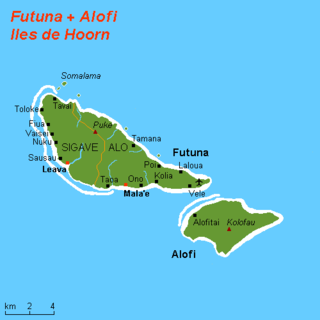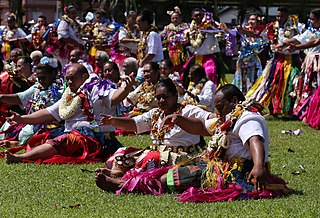
Wallis and Futuna, officially the Territory of the Wallis and Futuna Islands, is a French island collectivity in the South Pacific, situated between Tuvalu to the northwest, Fiji to the southwest, Tonga to the southeast, Samoa to the east, and Tokelau to the northeast.

The official flag of Wallis and Futuna is the French national flag, as it is a French territory. Wallis and Futuna has a locally used unofficial flag which bears the French flag in the canton.

Politics of Wallis and Futuna takes place in a framework of a parliamentary representative democratic French overseas collectivity, whereby the President of the Territorial Assembly is the head of government, and of a multi-party system. Executive power is exercised by the government.
The Samoic–Outlier languages, also known as Samoic languages, are a purported group of Polynesian languages, encompassing the Polynesian languages of Samoa, Tuvalu, American Samoa, Tokelau, Wallis and Futuna, and Polynesian outlier languages in New Caledonia, the Solomon Islands, Vanuatu, Papua New Guinea, and the Federated States of Micronesia. The name "Samoic-Outlier" recognizes Sāmoan.

Wallis is a Polynesian atoll/island in the Pacific Ocean belonging to the French overseas collectivity of Wallis and Futuna. It lies north of Tonga, northeast of Fiji, east-northeast of the Hoorn Islands, east of Fiji's Rotuma, southeast of Tuvalu, southwest of Tokelau and west of Samoa. Its area is almost 100 km2 (39 sq mi) with 8,333 people. Its capital is Mata Utu. Roman Catholicism is the predominant religion. Its highest point is Mount Lulu Fakahega. Wallis is of volcanic origin with fertile soil and some remaining lakes. Rainfall is plentiful.

Mata Utu is the capital city of Wallis and Futuna, an overseas collectivity of France. It is located on the island of Uvéa (ʻUvea), in the district of Hahake, of which it is also the capital. It is one of two ports in Wallis and Futuna, the other being at Leava on Futuna. Hihifo Airport, the main airport serving the island and city, is 5.6 kilometres (3.5 mi) to the northwest. Its population was 1,029 in 2018, up from 815 in 1998.
Wallisian, or ʻUvean, is the Polynesian language spoken on Wallis Island. The language is also known as East Uvean to distinguish it from the related West Uvean language spoken on the outlier island of Ouvéa near New Caledonia. The latter island was colonised from Wallis Island in the 18th century.
West Uvean is a Polynesian outlier language spoken on the island of Ouvéa, in the Loyalty island group of New Caledonia, and in the capital of Nouméa. It has long been in contact with Iaai, the Southern Oceanic language also spoken on the same island. Consequently, four vowels have been added, and the syllable structure has become complex, allowing for final consonants.

The Hoorn Islands are one of the two island groups of which the French overseas collectivity of Wallis and Futuna is geographically composed. The aggregate area is 115 km2, and the population 4,873.
Falakika Seilala, was a Queen of Uvea, ruling from 1858 until 1869. She introduced the title Lavelua for all the kings and queens of Uvea. She succeeded her brother Soane-Patita Vaimua Lavelua, and was succeeded by her paternal niece Amelia Tokagahahau Aliki.
Kapeliele Tufele III was a king of Uvea, who ruled from 17 April 1950 until 17 November 1953. He was preceded by Pelenato Fuluhea, and succeeded by Aloisia Brial.
Soane Toke was a king of Uvea, ruling for one day on 11 December 1953. He was preceded by Kapeliele Tufele III, and succeeded by Aloisia Brial.

ʻUvea is one of the three official chiefdoms of the French territory of Wallis and Futuna in Oceania in the South Pacific Ocean.

In Uvea (Wallis) and Futuna, dances play a major cultural role. One sees dance in fakahaha'aga (festivals), to'oto'oga, or just for pure pleasure. In Uvea, the term faiva is used for dance, whereas the term mako is used. In Uvea and Futuna there is a katoaga which is only celebrated with the visit of chiefs and if lucky, with the Lavelua (King). As the years go by, dance and culture is still alive and well in Uvea and Futuna. The normal fakapale is given to the dancers for their magnificent dance. The following dances of Uvea and Futuna below are just some of the dances, or are the main dances seen in Wallisian and Futunan culture.

Wallis and Futuna, an overseas territory of France in Oceania has a rich Polynesian culture that is very similar to the cultures of its neighbouring nations Samoa and Tonga. The Wallisian and Futunan cultures share very similar components in language, dance, cuisine and modes of celebration.
Sylvain Jacques Brial is a Wallisian politician and former member of the French National Assembly.
Victor Brial is a Wallisian politician. He represented Wallis and Futuna in the French National Assembly from 1997 to 2007 and was president of the Territorial Assembly of Wallis and Futuna twice, first from 1997 to 1999, and again from 2007 to 2010.
Benjamin Brial was a Wallisian politician who represented Wallis and Futuna in the French National Assembly from 1967 to 1988 as part of the Union of Democrats for the Republic and then the Rally for the Republic. He was a member of the Brial family, involved in trade and politics in Wallis and Futuna.
Gil Brial is a politician from New Caledonia who is the leader of the Caledonian People's Movement.









